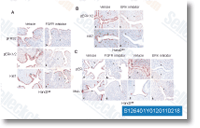The achievable role of CMV inside the pathogenesis of thyroid cancer isn’t supported by our study. Background XB130 is a newly found adaptor protein for intracellular signal transduction, it is involved in gene regulation, cell proliferation, cell survival, cell migration, and tumorigenesis. Nevertheless, its expression and part in pancreatic ductal adenocarcinoma haven’t been investigated. The present study was created to clarify the prognostic significance of XB130 expression in PDAC. Procedures A total of 76 consecutive patients with surgically resected PDAC had been retrospectively reviewed. XB130 expression was detected by immunohistochemical evaluation on the paraffin embedded tumour sections.Correlation among the expression of XB130 and clinicopathological parameters was analyzed.
XB130 expression was significantly upregulated in PDAC in comparison with normal pancreas. Increased XB130 expression was correlated kinase inhibitor NU7441 with lymph node metastasis, distant metastasis, high tumour node metastasis stage, and higher tumour grade. The survival of 43 sufferers with high XB130 expression was significantly worse than that on the 33 patients with low XB130 expression. Univariate analysis showed that higher XB130 expression, tumour size, distant metastasis, TNM stage and lymphatic metastasis had been independent prognostic components of postoperative survival. Multivariate analysis using the Cox proportional hazards model showed that high XB130 expression and distant metastasis had been considerable independent risk components Conclusions XB130 was overexpressed within the PDAC.
XB130 can be a promising pathological marker for the prediction of outcome in patients with PDAC. Key phrases Pancreatic ductal adenocarcinoma, Immunohistochemistry, Prognosis, XB130 Background Pancreatic ductal adenocarcinoma is amongst the most devastating human malignancies. Surgical resection remains the selelck kinase inhibitor only potentially  curative therapeutic solution. In the time of initial diagnosis, only a minority of patients with PDAC are at a disease stage that may still potentially be cured by resection. Even if a potentially curative resection can be performed, the five year overall survival is low at ten to 25%. Because of the lack of solutions for the early diagnosis and limited understanding on the biological features of PDAC, the majority of individuals are not diagnosed appropriately until the advanced stage. Prognostic factors for PDAC happen to be nicely studied, and consist of gender, age, size and location on the tumour, stage, lymph node metastasis, tumour grade, and serum carbohydrate antigen 19 9 level. Nevertheless, none of these established clinical markers have correlated with outcome and therapeutic response in patients with PDAC.
curative therapeutic solution. In the time of initial diagnosis, only a minority of patients with PDAC are at a disease stage that may still potentially be cured by resection. Even if a potentially curative resection can be performed, the five year overall survival is low at ten to 25%. Because of the lack of solutions for the early diagnosis and limited understanding on the biological features of PDAC, the majority of individuals are not diagnosed appropriately until the advanced stage. Prognostic factors for PDAC happen to be nicely studied, and consist of gender, age, size and location on the tumour, stage, lymph node metastasis, tumour grade, and serum carbohydrate antigen 19 9 level. Nevertheless, none of these established clinical markers have correlated with outcome and therapeutic response in patients with PDAC.
Natural Product
A natural product is a chemical compound or substance produced
